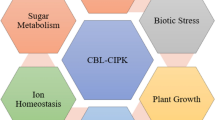Abstract
Catalase plays a central role in plant stress responses but is highly susceptible to photoinhibition. A rice catalase-B protein avoiding photoinhibition was developed by mutagenesis of specific amino acids: Leu-189 to Trp-189 and His-225 to Thr-225 and then recombinantly expressed in E. coli. In addition, the site specific mutation also induced 2–2.5-fold increase in enzyme velocity with high affinity for its substrate and showed nearly a 3-fold lower K m than the wild protein. These characteristic of mutated rice catalase-B is highly promising in transgenic research to increase plant productivity under stress conditions.




Similar content being viewed by others
References
Aebi H (1983) Catalase. In: Bergmeyer HU (ed) Methods of enzymatic analysis, vol 3. Verlag Chemei, Weinheim, pp 273–285
Bai Y, Zhang YL, Jin FG et al (2003) Recombinant Helicobacter pylori catalase. World J Gastroenterol 9:1119–1122
Brisson FL, Zelitch I, Havir AE (1998) Manipulation of catalase levels produces altered photosynthesis in transgenic tobacco plants. Plant Physiol 116:259–269
Chamnongpol S, Willekens H, Langebartels C et al (1996) Transgenic tobacco with a reduced catalase activity develops necrotic lesions and induces pathogenesis-related expression under high light. Plant J 10:491–503
Cheng L, Kellogg EW III, Packer L (1981) Photoinactivation of catalase. Photochem Photobiol 34:125–129
Engel N, Schmidt M, Lutz C et al (2006) Molecular identification, heterologous expression and properties of light—insensitive plant catalase. Plant Cell Environ 29:593–607
Feierabend J, Engel S (1986) Photoinactivation of catalase in vitro and in leaves. Arch Biochem Biophys 251:567–576
Foyer CH (1997) Oxygen metabolism and electron transport in photosynthesis. In: Scandalios JG (ed) Oxidative stress and the molecular biology of antioxidant defenses. Cold Spring Harbor Press, New York, pp 597–621
Foyer CH, Noctor G (2003) Redox sensing and signaling associated with reactive oxygen in chloroplasts, peroxisome and mitochondria. Physiol Planta 119:355–364
Higuchi R (1990) Recombinant PCR. In: Innis MA, Gelfand DH, Sninsky JJ et al (eds) PCR protocols: a guide to methods and applications. Academic Press, San Diego, pp 177–183
Kono Y, Fridovich J (1982) Superoxide radical inhibits catalase. J Biol Chem 257:5751–5754
Lilie H, Schwarz E, Rudolph R (1998) Advances in refolding of proteins produced in E. coli. Curr Opin Biotech 9:497–501
Margoliash E, Novogradsky A, Schejter A (1960) Irreversible reaction of 3-amino -1, 2, 3—trizole and related inhibitors with the protein of catalase. Biochem J 74:339–348
Mittler R (2002) Oxidative stress, antioxidants and stress tolerance. Trends Plant Sci 7:405–410
Scandalios JG (1994) Regulation and properties of plant catalases. In: Foyer HCH, Mullineaux MPH (eds) Causes of photooxidative stress and amelioration of defense systems in plants. CRC Press, Boca Raton, pp 275–315
Sekhar NP, Kavi KBP, Reddy AL et al (2006) In silico modeling and hydrogen peroxide binding study of rice catalase. In silico Biol 6:435–447
Sevinc MS, Mate MJ, Switala J, Fita I et al (1999) Role of the lateral channel in catalase HPII of Escherichia coli. Protein Sci 8:490–498
Shimizu N, Kobayashi K, Hayashi K (1984) The reaction of superoxide radical with catalase. Mechanism of the inhibition of catalase by superoxide radical. J Biol Chem 259:4414–4418
Switala J, Loewen PC (2002) Diversity of properties among catalases. Arc Biochem Biophys 401:145–154
Willekens H, Chamnongpol S, Davey M et al (1997) Catalase is a sink for H2O2 and is indispensable for stress defence in C3 plants. EMBO J 16:4806–4816
Zamocky M, Koller F (1999) Understanding the structure and function of catalases: clues from molecular evolution and in vitro mutagenesis. Prog Biophys Mol Biol 72:19–66
Zhoul Y, Lam MH, Zhang J (2007) Inhibition of photosynthesis and energy dissipation induced by water and high light stresses in rice. J Exp Bot 58:1207–1217
Acknowledgements
The authors are thankful to The Director, Institute of Life Sciences, Orissa, for support. MR gratefully acknowledges the UGC for financial help.
Author information
Authors and Affiliations
Corresponding author
Rights and permissions
About this article
Cite this article
Mondal, P., Ray, M., Kar, M. et al. Molecular identification and properties of a light-insensitive rice catalase-B expressed in E. coli . Biotechnol Lett 30, 563–568 (2008). https://doi.org/10.1007/s10529-007-9553-9
Received:
Accepted:
Published:
Issue Date:
DOI: https://doi.org/10.1007/s10529-007-9553-9




